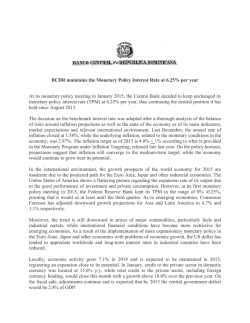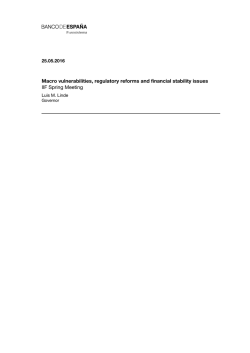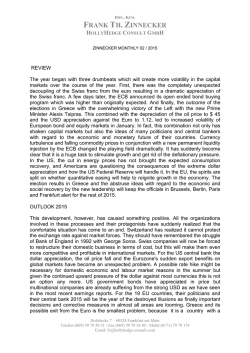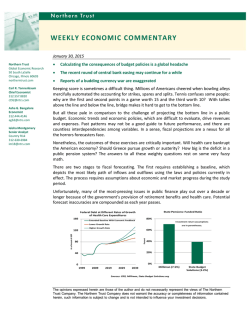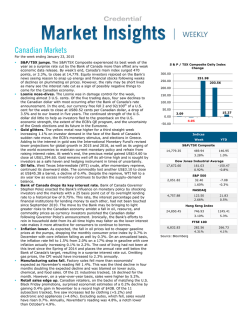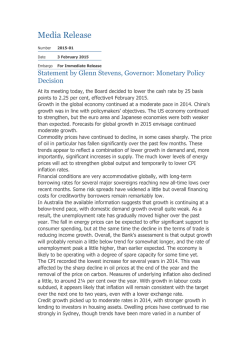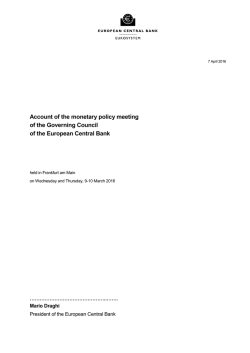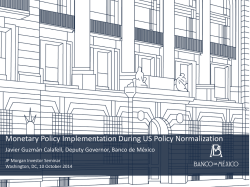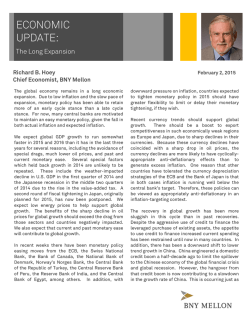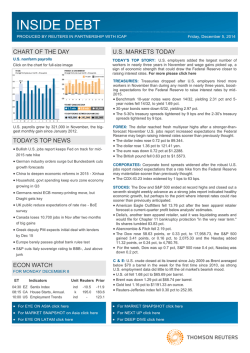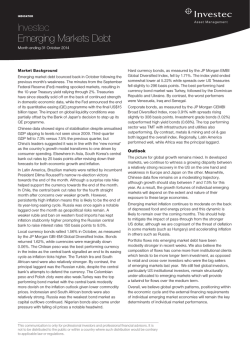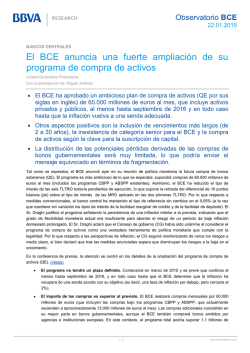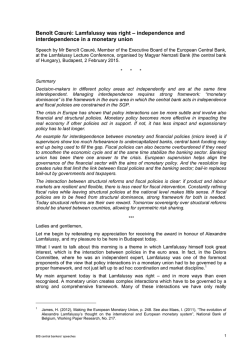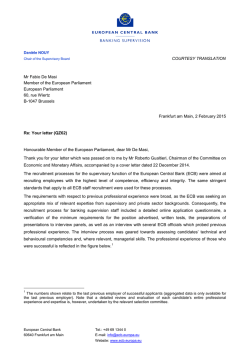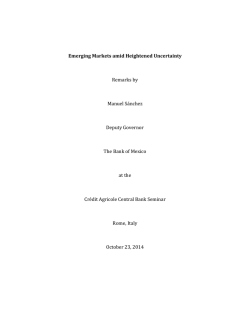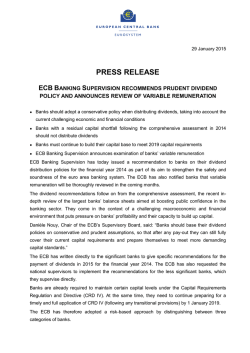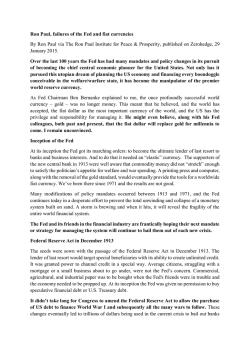
Governor. Fundación de Estudios Financieros/Fundación ICO
28.01.2015 Monetary policy: current situation and challenges Closing remarks at the launch of the yearbook “Anuario del euro 2014”/ Fundación de Estudios Financieros-Fundación ICO Luis M. Linde Governor of the Banco de España Firstly, I would like to thank Irene Garrido, chairwoman of ICO, Fernando Fernández and Juan Carlos Ureta for kindly inviting me to attend the launch of this new edition of the “Anuario del Euro”. I will begin by reviewing the current economic situation in the euro area and the measures adopted by the European Central Bank. Then I will go on to briefly comment on the leeway available to monetary policy in a context of very low inflation rates, and conclude by saying something about the different position in the monetary policy cycle of the main developed economies. The economic situation in the euro area and the ECB’s monetary policy The euro area's economy is in a situation of weakness, with overall expected growth of 0.8% for 2014. After remaining fairly dynamic in first quarter of 2014, GDP grew only modestly in the following two quarters, and according to available forecasts, the path of recovery, both in the short and medium term, will be fragile, with disparities between countries. According to the European Central Bank’s projections, in line with the consensus, 2015 and 2016 will see growth of 1% and 1.5%, respectively. These rates are not only modest, but are also subject to certain risks, which, on balance, point to even lower increases in economic activity. Turning to prices, for some months now inflation has been well short of the 2% benchmark, which is the ECB’s medium-term monetary policy target. The forecasts available continue to point to the risk of inflation remaining too low for too long. The ECB’s latest projections entail a further downward revision, with inflation expected to stand at 0.7% in 2015 and 1.3% in 2016. In recent months, against a background in which, given the weakness of demand and fierce competition, firms have limited price-setting power, the slump in the price of oil has exacerbated the drop in inflation. At the end of 2014, the annual rate of inflation stood at 0.2% (the average rate in 2014 was +0.4%) and it is expected to remain at very low or negative levels in the early months of 2015. This heightens the risk of second-round effects on wages and prices that could have an adverse impact on inflation expectations in the medium term. Indeed, the latest private sector forecasts have seen substantial downward revisions for all terms. Thus, for example, according to the January edition of Consensus Forecasts, the leading private sector economic forecast publication, the average rate of inflation forecast for 2015 is just 0.1%, compared with 0.6% forecast for the same period a month earlier. In a macroeconomic context of weak demand, these rates, so far from 2%, not only endanger the current anchoring of medium-term inflation expectations, but also heighten the risks to price stability and hamper the economic recovery of the area as a whole. These difficulties are more marked for the countries that are in the process of correcting imbalances built up in the past, and in particular for those, such as Spain, that have suffered competitiveness losses and need to contain their prices and costs more than in the euro area on average. 3/6 To address these risks the ECB has in recent months taken further measures to make its highly expansionary monetary policy even more expansionary. As regards standard measures, the ECB has reduced the interest rate on its main refinancing operations to 0.05%, which is technically the lower bound for this rate. Also, the interest rate on the deposit facility, which is the rate at which the cash surpluses that credit institutions hold in their Eurosystem accounts are remunerated, stands at negative levels (-0.20%), which discourages the accumulation of such balances and stimulates lending. Recent actions also include non-standard measures: a new long-term financing facility specifically aimed at promoting greater lending to the private sector; and two asset purchase programmes, one for asset-backed securities and the other for different types of covered bonds. Finally, on 22 January, the ECB announced new monetary stimulus measures. The interest rate applicable to the long-term financing facility, which aims to stimulate lending, was reduced and an expanded asset purchase programme was announced. This programme includes, in addition to the purchases of asset-backed securities and covered bonds issued by the private sector, purchases of bonds issued by euro area central governments, agencies and European institutions. The size of this expanded programme is ambitious, with monthly purchases amounting to €60 billion. The purchases will commence in March and, in principle, it is intended that they will be carried out until September 2016, although the Governing Council of the ECB has given itself the option to continue to make purchases if the path of inflation is not consistent with its aim of achieving inflation rates below, but close to, 2% over the medium term. The programme requires that, to be eligible for purchase, securities must be at least investment grade, or if not, that their issuers are under an EU-IMF financial assistance programme. These conditions are similar to those applied in the requirements for collateral to be eligible for monetary policy operations and those envisaged, in August 2012, in the announcement of the sovereign bond purchase programme known as Outright Monetary Transactions (OMTs). Of the additional asset purchases, 12% will be purchases of bonds issued by European institutions and the other 88% will be purchases of bonds issued by central governments and agencies of countries in proportion to their shares in the ECB’s capital key. The national central banks will purchase the bonds issued by European institutions and most of the domestic bonds, the ECB purchasing 8% of the latter. According to our preliminary estimates, the purchases of Spanish government debt will amount to some €100 billion over the time horizon considered. The agreement reached means that, in the hypothetical event that losses arise from these operations, the national central banks would assume the risks of their purchases of government bonds, while the risk of the purchases of the bonds of European institutions 6 4/6 and of sovereign bonds by the ECB would be shared by all the members of the Eurosystem. Monetary policy leeway in a very low inflation environment Let me now comment briefly on two matters of importance in the current context: the leeway available to monetary policy in a very low inflation environment and the different cyclical moment of monetary policy in the main developed economies. The particularly low inflation rates and the prospect that they will remain at similar levels for a prolonged period reduce the scope for monetary policy to bring the financing conditions of the economy into line with its cyclical position when that position is characterised by notable weakness. Conventional monetary policies based on setting short-term nominal interest rates reach their lower bound when rates approach 0%. At that point, any additional monetary stimulus would require non-standard measures designed either to shape agents’ expectations as to future interest rate behaviour or to change the size and composition of the central bank’s balance sheet. Balance sheet expansion through programmes to purchase public and private securities is unquestionably an exceptional measure, but it is not exclusive to the euro area, and has already been adopted by other central banks. Between 2010 and 2014 the Federal Reserve, the Bank of England and the Bank of Japan doubled the size of their balance sheets after running out of room to further reduce interest rates and after having resorted to announcing their commitment to hold official interest rates at very low levels for a sufficient time. The design and implementation of programmes to purchase public and private debt securities must not fail to take into account the institutional characteristics of the area in which they are applied. Monetary policy in the United States or in the United Kingdom acts in a fiscal union, which makes it easier to resolve potential problems associated with the allocation of any costs incurred by the central bank in its monetary policy operations. In this respect, the unique characteristics of the euro area meant that complex technical adjustments had to be made when designing the announced programme. The monetary expansion measures taken by central banks are unquestionably vital for achieving the objectives in terms of inflation rates and credit flow stimulation and of the financing of the economy. However, sustainably bolstering economic activity and job creation requires the monetary stimuli to be accompanied by measures in other areas. In the European case, the reform drive has to be maintained to ensure the proper functioning of the markets and fiscal policies favouring growth while at the same time meeting the commitments assumed under the Stability and Growth Pact. Position in the cycle and monetary policies of the main developed economies To conclude, I would like to refer to the different position in the cycle of the leading developed countries. 5/6 In the United States, and to a lesser extent in the United Kingdom, both of which are at a much more advanced stage of economic recovery than the euro area, the monetary policy debate now centres on when and how rapidly to start withdrawing part of the monetary stimulus, whereas in the euro area and in Japan further stimulus measures are being introduced. This difference in cyclical position is affecting prices on the financial markets, and particularly exchange rates. In this respect, the exceptional stimulus measures announced by the ECB and the consequent easing of financial conditions in the currency area, the depreciation of the euro and the sharp drop in oil prices provide a favourable financial backdrop for the euro area and, in particular, for countries like Spain that have made a tremendous effort to correct their imbalances. The benefits of the adjustments made under adverse conditions may now be further bolstered by a favourable financial climate. It is important that the Spanish economy consolidate these gains and that it maintain the pace of reform and the improvements in competitiveness in a framework of stability. 6 6/6
© Copyright 2026
